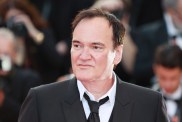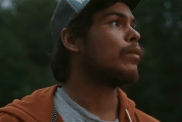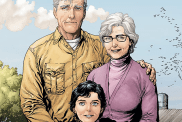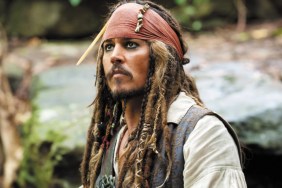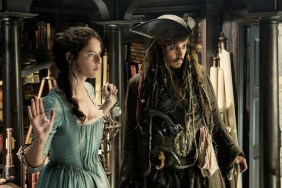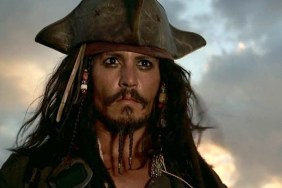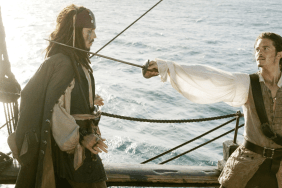
“Jack is actually captured and brought in to visit the King of England. [He] makes an escape, and we have a chase through the streets of London in the 1750s.”
John Myhre, the production designer on Pirates of the Caribbean: On Stranger Tides is excitedly describing a sequence near the beginning of the film. It’s been minutes since we were introduced to him, on the backlot of Pinewood Studios, England, and it’s already clear this is a man who loves his job.
“So we started out needing to have streets that looked like they’re rich and regal and royal, and we’re using Greenwich Naval academy at the start of that,” Myhre’s description of the scene moves from what we see, to the logistics behind it, “And then we need to be right down on the wharfs, so the working area, down near the water. We’ll show you the set we actually built for that”.
With that, Myhre leads us through a maze of camera vehicles, workmen and replica 18th Century carts, towards a vast wall at the back of the working area. As he does so, he continues talking about the chase, “We needed a place that looks like really down by the wharfs, and that we could have an awful lot of control, so we have to build [it] as a backlot piece.”
It’s then that we walk past the ‘wall,’ and it becomes apparent that it is, in fact, the rear of the ‘backlot piece.’ To our right is the wharf, a structure about thirty feet tall that wouldn’t look out of place on the banks of the Thames; to our left is a narrow, cobbled street a stylised version of London in 1750 that looks like it’s straight out of a Disney park.
Walking up the street is a somewhat bizarre experience. In spite of knowing full well that the buildings are, literally, a façade, it’s almost impossible to reconcile this with what we’re seeing: a winding, slightly claustrophobic London alley, complete with timber framed buildings and low-hanging masonry. What’s really remarkable is that this is only one iteration of the street, as Myhre explains.
“We’re actually changing this street, a couple times to make it look longer. You know it’s just this tiny piece of a street. We’re filming it in three different ways, making it feel like it’s three times as long. So we’re changing dressing, and taking buildings down and changing it out a little bit.”
As we walk back down the street towards the wharf, Myhre stops by a building, “this is our Captain’s Daughter’s Pub,” he opens the door, allowing us to glimpse the interior. It’s sparsely furnished, and doesn’t look quite right sort of a sketch of the inside of a pub. Myhre explains, “[these are] some of the architectural elements, so, when you’re on this street, that’s all you see in the door.”
A few minutes later, after a brief walk through the studio lot, we’re once more outside The Captain’s Daughter, this time inside a sound stage. Here it is the exterior that is a sketched-out version, the shape is the same, and there are cobbles on the floor outside, but the door is missing, and the other side of the street has been rendered with a matte painting. “The actual door we had for our set here is out on the back lot right now,” Myhre tells us, “some of the pieces that would be inside are out there now, so we’d open up the door in the back lot, and it leads into here.”
Inside the pub it is very small, and very cluttered. In addition to the counter, ceiling supports, imitation candles and a hell of a lot of furniture, are some very 21st Century touches: an air conditioning unit, a selection of stands and all sorts of clutter, “Now what you guys are all seeing is the what the shooting crew does to our beautiful sets”, Myhre laments “When the shooting crew comes in, this is all dressed beautifully, all the furniture, chairs, everything is in the perfect place, candles lit, everything gorgeous. But when they shoot, they need to be able to clear portions out, so if we’re filming somebody at the bar area over there, they’d have the actors there, but they would literally just take all this away”.

At the back of the Captain’s Daughter is a door that leads through to the Storeroom set. Myhre shows us through. In contrast to the previous room, with it’s low ceiling, and cramped conditions, the Storeroom is vast, about 30 feet across, by 40 feet deep, with walls that reach up nearly as high as the room is wide.
Around the side and back walls is a mezzanine, with props scattered along it, and a ramp leading up. Beneath are more props, and in the centre, what appears to be a huge drain, at least six feet in diameter, with a grate over the top. Myhre seems justifiably proud of the set, and the team who built it, “I think, I just got the best construction and paint and plaster team I could ever dream of having here in England, and the local art department here, our supervisor and art director, Gary Freeman is just astonishing.”
In the far corner of the room is a large round table surrounded with chairs, set up for interviews. It was here that we spoke with screenwriter Terry Rossio, one half of the writing team behind the three previous “Pirates” films, as well as “On Stranger Tides.”
“We’re in the world of ghosts stories, and stories of the sea, and elements that are associated with pirates, sort of gothic elements, historical elements, romantic elements,” Rossio explains, “Within that world, there are certain things that we get excited about defining what they are; like for example the Flying Dutchman, Davy Jones, Davy Jones’ Locker, those sorts of things are in the public consciousness but maybe not quite clearly defined.”
This technique, of layering a novel take on popular myths and legends with elements of the real world clearly appeals to Rossio, and it’s something he seems to have relished this time round.
“When you have an opportunity to then actually do another ‘Pirates of the Caribbean’ film, you can’t help but say, well let’s see: mermaids, we’ve mentioned them but we haven’t really explored them; The Fountain of Youth, that’s something people know about but what is it really? Black Beard, Queen Anne’s Revenge is his ship, those are elements that sort of scream out because they’re iconic, somewhat well known, but yet undefined. So how cool it will be to define those sort of things?”
As well as the combination of real world and myth, the other element common to films in the “Pirates” franchise is Captain Jack Sparrow.
The man who stole the first three films from nominal protagonist Elizabeth Swann has taken centre stage in this movie and has influenced the direction of the script, both in character, with Rossio and writing partner Ted Elliot frequently asking themselves, “what haven’t we put him through yet, what haven’t we explored, what hasn’t he done emotionally?” and as actor Johnny Depp, who worked closely with the writing team during the development process, as Rossio explains.
“We had more early meetings with Johnny in terms of talking about what he was interested in doing, and then when we presented story elements, or presented plot elements, he was really involved. He was surprisingly, I think–surprising is not the right word–he was more involved, or significantly involved in coming up with story lines, inventing characters, creating moments that we would then fashion, shape and then go back, and pitch yet again. So that was different.”
While some screenwriters might resent the hands-on involvement of an actor in the writing process, Rossio is positive about the experience, “I personally would be frightened if it was only my opinion that was putting these things together, I wouldn’t want that, you don’t go into this, you don’t get anywhere unless you make use of the collective talent that’s assembled around you, and you have to be open to it, even when it conflicts with your own point of view.”
